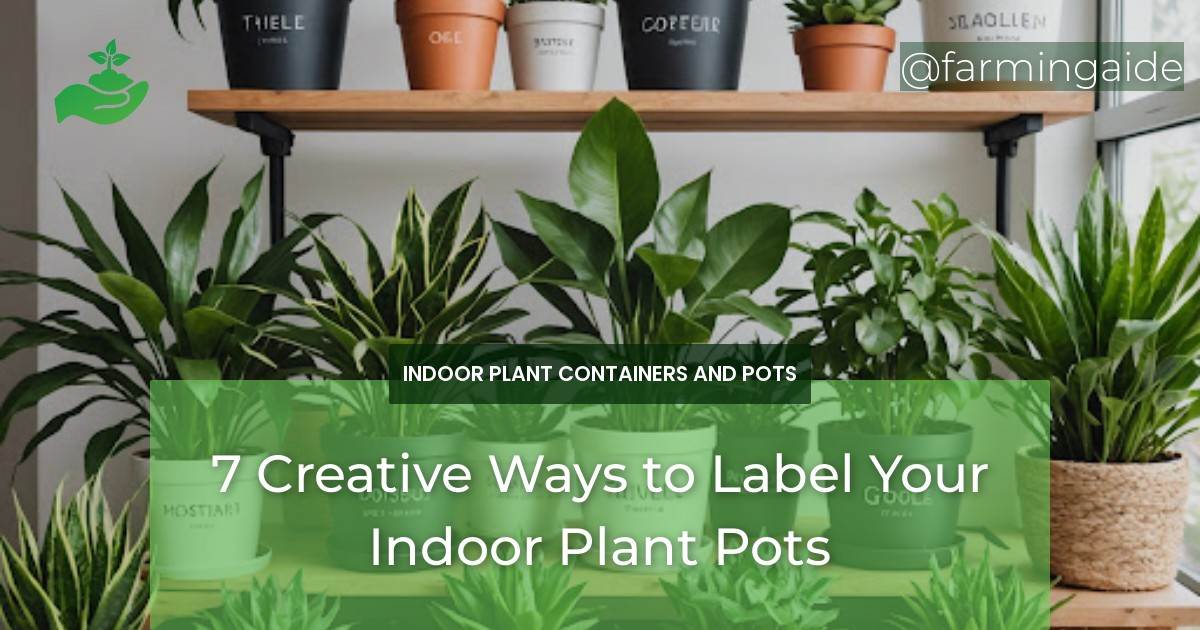Are you tired of rummaging through your indoor garden, trying to identify which plant is which? Do you struggle to keep your plant pots organized and labeled? You’re not alone! Many indoor gardeners face the same problem, but with a little creativity, you can turn plant labeling into a fun and functional aspect of your indoor gardening experience. In this article, we’ll explore 7 creative ways to label your indoor plant pots, helping you to keep your plants organized, and your indoor garden thriving.
Key Takeaways
- Importance of labeling indoor plants for organized gardening
- Creative labeling ideas for indoor plant pots
- Tips for effective plant labeling and maintenance
- DIY plant labeling methods for a personalized touch
- Benefits of organized plant pots for healthy plant growth
Introduction to Indoor Plant Labeling
Indoor plant labeling is an essential aspect of maintaining a healthy and thriving indoor garden. Without proper labeling, it can be challenging to keep track of which plant is which, leading to confusion and potential mistakes in care. Accurate labeling helps you identify the specific needs of each plant, ensuring you provide the right amount of water, sunlight, and nutrients. In this article, we’ll delve into the importance of plant labeling, traditional labeling methods, and explore 7 creative ways to label your indoor plant pots.
Importance of Plant Labeling
Proper labeling of indoor plants helps you keep track of essential care information, such as watering schedules, fertilization, and pruning. It also enables you to identify potential pests or diseases, taking prompt action to prevent their spread. Furthermore, labeling helps you distinguish between different plant varieties, ensuring you provide the right care and attention to each plant.
Benefits of Organized Plant Pots
Organized plant pots not only enhance the aesthetic appeal of your indoor garden but also promote healthy plant growth. With labeled plants, you can quickly identify plants that require specific care, ensuring they receive the necessary attention. This, in turn, leads to healthier plants, reduced maintenance, and a more enjoyable indoor gardening experience.
Traditional Labeling Methods
Traditional labeling methods include using tags and labels, handwritten labels on pots, and pre-made plant labels. While these methods are effective, they can be dull and lack personality. In the following sections, we’ll explore creative labeling ideas to take your indoor plant labeling to the next level.
ALSO READ
Using Tags and Labels
Tags and labels are a simple and easy way to label your indoor plants. You can use plastic or metal tags, attaching them to the plant pot or soil. This method is easy to implement and provides a clean, minimalist look.
Handwritten Labels on Pots
Handwritten labels are a personalized way to label your indoor plants. Simply use a permanent marker to write the plant’s name and care information directly onto the pot. This method adds a touch of personality to your indoor garden.
Creative Labeling Ideas
Now that we’ve covered traditional labeling methods, let’s dive into 7 creative ways to label your indoor plant pots.
ALSO READ
DIY Painted Pot Labels
Get creative with DIY painted pot labels. Use acrylic paint and a small brush to paint the plant’s name and care information directly onto the pot. This method adds a touch of personality and color to your indoor garden.
Engraved Wooden Labels
Engraved wooden labels are a beautiful and rustic way to label your indoor plants. Use a wood burning tool or a laser engraver to add the plant’s name and care information to a wooden label.
Chalkboard Paint Labels
Chalkboard paint labels are a versatile and easy-to-use labeling method. Simply paint a small area of the pot with chalkboard paint, and use chalk to write the plant’s name and care information.
Stamped Metal Tags
Stamped metal tags are a modern and industrial way to label your indoor plants. Use metal stamping tools to add the plant’s name and care information to a metal tag, attaching it to the pot or soil.
Mosaic Tile Labels
Mosaic tile labels are a colorful and eye-catching way to label your indoor plants. Use small tiles and adhesive to create a mosaic pattern on the pot, adding the plant’s name and care information.
3D Printed Labels
3D printed labels are a futuristic and high-tech way to label your indoor plants. Use a 3D printer to create custom labels with the plant’s name and care information.
Tips for Effective Plant Labeling
Now that we’ve explored creative labeling ideas, let’s discuss some essential tips for effective plant labeling.
Choosing the Right Materials
When choosing labeling materials, consider the durability and weather resistance of the material. Ensure the label can withstand moisture, sunlight, and other environmental factors.
Ensuring Durability
To ensure the label remains readable over time, use durable materials and consider applying a clear coat or sealant to protect the label from the elements.
Keeping Labels Visible
Place labels in a visible location, ensuring they’re easily readable. Avoid placing labels in areas prone to moisture or direct sunlight, which can cause the label to deteriorate.
Conclusion and Final Thoughts on Plant Labeling
In conclusion, labeling your indoor plant pots is an essential aspect of maintaining a healthy and thriving indoor garden. By exploring traditional labeling methods and incorporating creative labeling ideas, you can take your indoor gardening experience to the next level. Remember to choose durable materials, ensure label durability, and keep labels visible to ensure your indoor garden remains organized and thriving.


